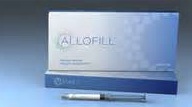There have been numerous injectable fillers for facial use that have become commercially available since 2002 when the product concept was introduced. All of these fillers have been of the synthetic variety containing mainly resorbable and a few non-resorbable materials. While these are convenient off-the-shelf products, almost all only offer a temporary augmentation effect.
Fat grafting as become a popular form of facial voluminization as it offers the potential for better long-term augmentation. It achieves that effect as it is harvested from the patient and such autologous fat cells can potentially survive the transfer process. But it is a surgical procedure and not a ready made product.

In theory, Allofill offers the convenience of a premade injectable filler with the long-lasting results of fat grafting. The former is absolutely true, the latter awaits long-term clinical studies to substantiate. It is available in a 3cc syringe which is two to three more than all other injectable fillers.
Dr. Barry Eppley
Indianapolis, Indiana


